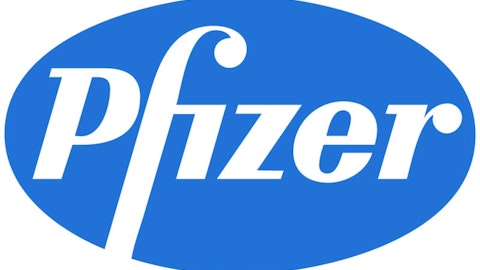Large, multinational companies have an unprecedented number of things pulling and pushing on their share price. Pfizer Inc. (NYSE:PFE), the world’s largest pharmaceutical company, is no different. It can be difficult to keep up with every booming product, failed trial, and promising drug candidate nestled within the giant’s pipeline. Sometimes to keep up with the complexity, investors need to think simple. Sit down, make a list of important catalysts and anchors, and research each one. Here are three things that I found that will affect Pfizer stock in the rest of 2013.
Complete spinoff of animal health division
When Pfizer Inc. (NYSE:PFE) kicked Zoetis Inc (NYSE:ZTS) out of the nest earlier this year, it held on to 80% of the company. Now the pharmaceutical giant wants to boot its remaining 401 million shares in an effort to boost earnings and focus on pharma. Animal health is an important and steadily growing international industry, but it just doesn’t bring the same margins as prescription drugs. That’s probably why Pfizer shares rose 3% after announcing plans to unload its massive stake in Zoetis.

Sales of Xeljanz
Late last year the FDA approved Xeljanz, a novel JAK inhibitor with blockbuster potential, for rheumatoid arthritis. That made Pfizer Inc. (NYSE:PFE) the first company to boast such a drug for use in the multi-billion dollar autoimmune market. The drug was specifically approved as a first-line treatment after or in conjunction with methotrexate — the absolute first drug used by doctors. Unfortunately, being first-to-market can bring its own set of challenges. Sales of $11 million during the drug’s first quarter on the market didn’t exactly blow anyone away.
It will need to pick up the pace considerably if it is going to compete with the likes of Humira from AbbVie Inc (NYSE:ABBV), which brought in $2,244 million — tops in the world — in the same period. Analysts fearing generic and novel competition for Humira figure Xeljanz to be among the fiercest adversaries. As a small molecule, Xeljanz has lower manufacturing costs and has the advantage of being orally administered (many biologics are injected). So what’s with the slow start?
Aside from being rejected in Europe, doctors are not happy with its cost. Pfizer Inc. (NYSE:PFE) prices the drug at $2,000 per month — nearly the same amount as already expensive biologics. That won’t help Xeljanz get a foot in the door as a new treatment option, especially with the cautious approach to newer, less-proven drugs. It’s very early, but investors need to watch how well the therapy performs this year. Hopefully a massive data dump this June will encourage doctors to prescribe the drug in parallel to its potential and push European regulators to approve it at second glance.
Expanded indication for Prevnar13/Prevenar13
The third event that will toy with Pfizer Inc. (NYSE:PFE) stock in 2013 is an expanded indication for Prevnar13, a vaccine against Streptococcus pneuimoniae, which protects against pneumonia and meningitis. Prevnar13 is already approved for children 6 weeks to 17 years old and adults over age 50 in the United States, Europe, and dozens of other countries. A recent phase 3 trial evaluating the vaccine’s effectiveness in those aged 18-49 years — who were expected to be less responsive to inoculation — met all primary and secondary endpoints. Pfizer should have no problem gaining expanded approval for the new age group.
That will provide a solid boost to sales for the best-selling pneumococcal vaccine, which brought in $877 million in the first quarter. Prevnar13 already easily competes with Synflorix from GlaxoSmithKline plc (ADR) (NYSE:GSK) and Prevnar/Prevenar from Wyeth. Synflorix protects against 10 types of the bacterium and generated sales of just $116 million in the first quarter, while Prevnar (from Wyeth) protects against just seven. Pfizer Inc. (NYSE:PFE)’s Prevnar13 protects against, you guessed it, 13 types — giving it the broadest protection of any such vaccine. An expanded indication will further cement its stranglehold on the market and make it the only therapy approved for nearly any age group.


